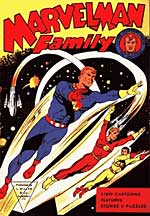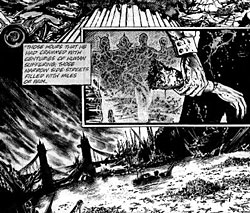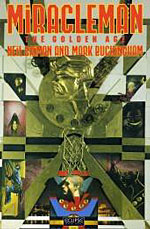>> Comment: A Shot Of MoCCA
>> Comment: He Could Be Wrong, He Could Be Wright
More...

MIRACLEMAN. Perhaps the most discussed, yet among least read superhero books in all of comics history. While Miracleman's origins are fairly simple - a young man is granted fantastic powers, a la Captain Marvel, with the utterance of "KIMOTA!" - the artistic origins of Miracleman are much more complex and befit the legal muddle Miracleman exists in today.
The rights to the character are in flux, which is why MIRACLEMAN has been read only by a select few comics fans: those who followed the series while it was still running, those who were fortunate enough to purchase the original trades when they were released, those who had friends kind enough to loan them out, and those with enough disposable income to pay anywhere from $10 to $100 per single issue on eBay.
Why is MIRACLEMAN an impossible series to read? Well, it's not the fault of the creators. If it were up to Neil Gaiman and Mark Buckingham - who Alan Moore passed the MIRACLEMAN torch to - the series would have been completed and reprinted long ago. But, I'm jumping ahead of myself. Let's start at the beginning and work from there.
HUMBLE ORIGINS
 Originally, Marvelman was a cheap imitation of a cheap imitation. To compete with Superman, Fawcett Publications created Captain Marvel. Captain Marvel was a success for Fawcett, but DC (then known as National Periodicals Publications, Inc.) thought Captain Marvel infringed on their Superman copyright. A lengthy legal battle ensued, and in 1953, Fawcett agreed not to publish any more Captain Marvel comics. This worked out well for both companies, as the superhero market in the 1950s had run out of steam and the only superheroes with any degree of success were Superman and Batman. The market was then dominated by EC Comics, who published war and horror comics.
Originally, Marvelman was a cheap imitation of a cheap imitation. To compete with Superman, Fawcett Publications created Captain Marvel. Captain Marvel was a success for Fawcett, but DC (then known as National Periodicals Publications, Inc.) thought Captain Marvel infringed on their Superman copyright. A lengthy legal battle ensued, and in 1953, Fawcett agreed not to publish any more Captain Marvel comics. This worked out well for both companies, as the superhero market in the 1950s had run out of steam and the only superheroes with any degree of success were Superman and Batman. The market was then dominated by EC Comics, who published war and horror comics.
There was still enough interest in superheroes over in the UK, though, and the demise of Captain Marvel was problematic for a company called L Miller & Sons, who had been repackaging American superhero books in black-and-white anthologies. Captain Marvel was a relative hit, and with Fawcett no longer publishing new Captain Marvel comics, the well for L Miller & Sons had effectively dried up.
In 1954, Mick Anglo created Marvelman for L Miller & Sons. Marvelman was similar enough to Captain Marvel that his adventures could run in place of the Captain Marvel stories, but he was different enough from Superman to escape any copyright infringement lawsuits.
Like Captain Marvel's alter ego Billy Batson with his superhero cry, "SHAZAM!" Marvelman's alter ego was a young man named Mickey Moran, who yelled the magic word, "KIMOTA!" and transformed into Marvelman, and then engaged in a series of increasingly daft adventures with Young Marvelman and Kid Marvelman. One of their arch-nemeses had the unfortunate moniker Young Nastyman. Marvelman's most engaging nemesis was Dr Emil Gargunza, a bald and bespeckled mad scientist cipher of Captain Marvel's Dr Sivana.
MARVELMAN was strictly a comic for children in the UK. Most children saw him as an inferior reproduction of Captain Marvel, but delighted in his adventures nonetheless.
One such child was Alan Moore. The character stuck in his head through to adulthood, and, being inspired by the "Superduperman" parody by Harvey Kurtzman in MAD magazine, Moore set out to revise Marvelman for a modern audience. In an interview with George Khoury, Alan Moore discussed his initial urge to reinvent Marvelman. He wanted to take "a very innocent and sort of simplistic 1950s super-hero and then [drop] him in a much more complex, darker 1980s environment".
In 1982, Marvelman was reborn in the pages of the anthology WARRIOR, which was also the first home to V FOR VENDETTA. From the very beginning, it was obvious that the character had undoubtedly changed. Since his previous adventures had ended, Mickey Moran had grown up and was now known as Mike Moran. He worked as a journalist, and amnesia had claimed his memories of Marvelman. After being plagued for years by a dream of flying, Moran remembers the magic word and calls out, "KIMOTA!" thus turning into Marvelman for the first time in his adult life.
INTRODUCING MIRACLEMAN
Moore's reinvention of MARVELMAN was a success for WARRIOR, but the anthology soon ended. There was interest in reprinting the anthologised series in comic book form in America, and also to complete the story. But there were problems. Specifically with the name "Marvelman".
To avoid a potential lawsuit from Marvel Comics, Marvelman's name was changed to Miracleman. Not a problem, really, except that as soon as the series began anew, the stakes were raised. According to rumour, while Moore consented to change Marvelman to Miracleman, he also decided that he would never thereafter do any work for Marvel Comics.
What's fascinating to note about Marvelman is that, when Alan Moore originally pitched to write the series, he had contingency plans in place in case WARRIOR was unable to secure the Miracleman rights. Moore's original proposal can be read in George Khoury's exhaustive KIMOTA!: THE MIRACLEMAN COMPANION, in which it's revealed that his contingency plan was to create a Marvelman cipher named "Miracle Man", who would transform himself with the cry of "Raelcrum!"
Once Marvelman became Miracleman, he was then truly Moore's creation. It may be that the change in identity was what gave Moore the sense of freedom that allowed him to write the controversial childbirth issue, as well as to turn the epic battle between Miracleman and Kid Miracleman into an out-and-out gore fest. Would Kid Marvelman have destroyed London with the same ferocity as Kid Miracleman?
The situation bears comparison with Moore's work on WATCHMEN. If Moore and Gibbons had been given the rights to use the original Charlton characters for the story, rather than having to create corollaries, one might wonder if it would have altered their approach to the series. Would the stakes have been as high for Blue Beetle as they were for Nite Owl? Would Moore's vision of Captain Atom have had the same detachment from humanity as Dr Manhattan?
On paper, of course, Marvelman continued just as planned, and it was only the name that had changed.
REINVENTING MIRACLEMAN
Initially, Mike Moran struggled to fit his new heroic persona into his extremely average existence. He sought out his origins first by tracking down Johnny Bates, Kid Miracleman, who had never transformed back to Johnny Bates. Instead, he'd lived as Kid Miracleman into adulthood and ran a cybernetics corporation. Bates is quite insane, and a war that would determine the fate of the world begins. The first battle is resolved through good old fashioned superheroic fistcuffs, and Bates is dispatched when he utters the word "KIMOTA!" He thus returns to his child form and is thought to be harmless, but this is not to be the case.
After tracking down his arch-nemesis, Dr Emil Gargunza, Miracleman discovers that his origins are not what he was led to believe. The first startling discovery is that Mike Moran never changed directly into Miracleman, but rather switched places with an alien being.
In the late 1940s, Gargunza was working for the British government. An alien spacecraft had landed in Wiltshire, and inside the craft was a dead creature who had "two of everything... two heads, intersecting with each other, two brains crushed together into an amorphous brown-grey mass... and yet it was one creature. It's cell-structure consistent throughout." Gargunza set out to replicate the alien creature's cell-structure on a human being. He wanted to create a superbeing.
To do so, Gargunza abducted an orphan, Mickey Moran, and subjected him to a series of experiments. He created a full-sized adult from Moran's living cells and placed this body in "infraspace", where it could be summoned by the activation of a brain implant, or more specifically, by uttering a catchphrase that was a post-hypnotic trigger. This experiment was dubbed Project Zarathustra.
Gargunza began to experiment on other children, Dicky Dauntless and Johnny Bates, thus creating the Miracleman Family. He kept them subdued and enslaved in their own dreams. He based these dreams on the exploits of a comic book superhero, Captain Marvel. The children's heroic fantasies kept them under Gargunza's control for many years until the government decided to shut down Project Zarathustra. Subsequently, the fantasies of the Miracle Family broke through into their real lives, leaving Dicky Dauntless dead, Mickey Moran amnesiac, and Johnny Bates fully cognizant and living his life as Kid Miracleman, becoming more and more deranged as time passes.
THE LEGEND OF MIRACLEMAN
Is MIRACLEMAN worth the hype? I certainly think so. This is the book that began the revisionist superhero movement. You can trace Alan Moore's growth as a writer throughout the series as the idea grows from taking a lame superhero with a ridiculous origin and creating a mythos around him. It's a rather simple concept, but it sparked dozens of re-imaginings throughout the superhero world, from Frank Miller's THE DARK KNIGHT RETURNS to Rick Veitch's THE BRAT PACK.
It's a nostalgic book, certainly, but to Alan Moore nostalgia is not a safe concept. In his original proposal, Moore stated that "Nostalgia, if handled wrong, can prove to be nothing better than sloppy and mawkish crap ... the central appeal of nostalgia is that all of this stuff in the past has gone. It's finished. We'll never see it again ... and this is where the incredible poignancy of nostalgia really comes in."
The sense of nostalgic despair is delicately handled by the range of artists who worked on MIRACLEMAN. The artistic tone was set by Gary Leach, whose highly detailed rendering of a London in the midst of economic turmoil and urban decay is perfectly offset by the bedraggled Mike Moran. With that first mumbled, "KIMOTA!" Miracleman emerges in a glorious reinterpretation of Mick Anglo's version, except with a keener and much more modern sense of outfit design. In one scene, members of Project Zarathustra watch as the emblem on an unconscious Miracleman's chest transforms itself from the awkward horizontal MM design into a stylised MM. The old days are certainly gone.
The sublime Alan Davis took over the art chores on MIRACLEMAN for a brief spell as Miracleman sought to define himself in modern times. Rick Veitch and Chuck Austen (working under the name Chuck Beckum) gave their interpretations of MIRACLEMAN, offering new life and new perspectives, but it wasn't until John Totleben took hold of the reins that the book took aim and drove towards a startling and horrific conclusion.
 Johnny Bates had returned and rampaged through London with a destructive zeal the likes of which had never been seen before in comics. Truly, if a world were to exist with super-beings in it, their battles would be more ferocious than anything seen in a DC or Marvel comic.
Johnny Bates had returned and rampaged through London with a destructive zeal the likes of which had never been seen before in comics. Truly, if a world were to exist with super-beings in it, their battles would be more ferocious than anything seen in a DC or Marvel comic.
Moore already had his eye set on depicting Miracleman's world as a world exactly like ours. When Miracleman needs to fly great distances with his human wife, Liz Moran, he doesn't pick her up and carry her in his arms across continents. He has her sit in a car while he flies the car through the skies, knowing that she wouldn't survive the elements or his velocity without protection.
What this says is that human beings are fragile creatures. And when Johnny Bates begins his path of destruction through London, we see exactly how fragile we are. Totleben renders every panel in intense detail, working through the pathology of Bates' mind. Miracleman and Bates fight to the bone, and when Bates reverts back to his human form, Miracleman is forced to dispatch Bates forever.
All this death and destruction causes Miracleman to rethink his purpose. He recreates the world as a utopia, and hides himself away at the top of the world, thinking that he's done the right thing. All wars end, and the world is a peaceful, safe place, where the sick are cared for and human kind works together.
THE BATTLE FOR MIRACLEMAN
At this point in the story, Moore ended his run on MIRACLEMAN and passed the torch to Neil Gaiman and Mark Buckingham. Gaiman immediately saw flaws in the perfect society that Miracleman had created, and set about slowly unravelling this world. Gaiman's run on MIRACLEMAN was brief due to the bankruptcy of Eclipse Comics and its subsequent purchase by Todd McFarlane.
Gaiman's vision of Miracleman was very different to Moore's. Both saw the character as a being of incredible perfection living amongst flawed beings. Creatively, Gaiman had quite a difficult chore to follow up Moore's work, but what he did, though brief and unfinished, was transcendent. In Gaiman's first story arc, "The Golden Age", Miracleman had become a demagogue in a world of his own creation, where the dead lived on in an underground city. A series of Andy Warhol-esque beings worked to help Gargunza reform as a more sympathetic creature, and Miracleman revived Dicky Dauntless to life, only to be rejected by him when he urged Dauntless to accept his sexuality.
 The series ended after only two issues of Gaiman and Buckingham's second arc, "The Silver Age." A third issue was partially completed partially completed, but never went to press. All we have now is Gaiman's promise to finish the series once the copyright is resolved. Miracleman was partially owned by its creators and by Eclipse. The ownership changed hands from creator to creator, but when Todd McFarlane purchased the Eclipse Comics lot, he claimed ownership of Miracleman and has thus stalled the completion of Gaiman's run.
The series ended after only two issues of Gaiman and Buckingham's second arc, "The Silver Age." A third issue was partially completed partially completed, but never went to press. All we have now is Gaiman's promise to finish the series once the copyright is resolved. Miracleman was partially owned by its creators and by Eclipse. The ownership changed hands from creator to creator, but when Todd McFarlane purchased the Eclipse Comics lot, he claimed ownership of Miracleman and has thus stalled the completion of Gaiman's run.
Subsequently, Neil Gaiman created Marvels & Miracles, LLC to once and for all resolve the copyright debacle over Miracleman. It's become quite a muddle, to the point where it's suggested actual ownership might never have passed between WARRIOR editor Dez Skinn, who had originally held the 1950s MARVELMAN copyright, and Alan Moore.
The series itself never ran on a consistent publishing schedule. At times, months would pass between issues. This problem first arose after the WARRIOR reprints had all been run in America, and once again when John Totleben was completing the "Olympus" storyarc. Totleben was diagnosed with a degenerative retinal condition called Usher Syndrom Type II, wherein his vision became increasingly blurry. It's a testament to his artistic dedication that he was able to continue on with MIRACLEMAN and even to craft such a detailed vision of the apocalypse.
When Gaiman and Buckingham began their work on MIRACLEMAN, publishing delays were often caused by the two creators waiting for the checks to arrive for the previous issue before setting to work on the current one. Eventually, the checks simply stopped arriving, and Eclipse went bankrupt.
It has been rumoured that Marvel Comics will publish the entirety of MIRACLEMAN in trade format when the rights issues are resolved, and that Gaiman and Buckingham will complete "The Silver Age" and round out the series with "The Dark Age", in which the saga of Miracleman will be resolved. As time passes, the anticipation once felt by old fans of the series might waver, but the increasing chatter from the fans who have yet to ever experience MIRACLEMAN helps the legend grow stronger. It feels like it's simply a matter of time before this series is collected once again. When it happens, we should all be in for a treat.
With thanks to George Khoury's KIMOTA!: THE MIRACLEMAN COMPANION and The Alan Moore Fan Site.

This article is Ideological Freeware. The author grants permission for its reproduction and redistribution by private individuals on condition that the author and source of the article are clearly shown, no charge is made, and the whole article is reproduced intact, including this notice.


